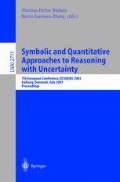Abstract
This paper describes classification of aerial missions using first-order discrete Hidden Markov Models based on kinematic data. Civil and military aerial missions imply different motion patterns as described by the altitude, speed and direction of the aircraft. The missions are transport, private flying, reconnaissance, protection from intruders in the national airspace as well as on the ground or the sea. A procedure for creating a classification model based on HMMs for this application is discussed. An example is presented showing how the results can be used and interpreted. The analysis indicates that this model can be used for classification of aerial missions, since there are enough differences between the missions and the kinematic data can be seen as observations from unknown elements, or states, that form a specific mission.
Access this chapter
Tax calculation will be finalised at checkout
Purchases are for personal use only
Preview
Unable to display preview. Download preview PDF.
References
Appriou, A.: Multisensor Data Fusion in Situation Assessment Processes. In: Nonnengart, A., Kruse, R., Ohlbach, H.J., Gabbay, D.M. (eds.) FAPR 1997 and ECSQARU 1997. LNCS, vol. 1244, Springer, Heidelberg (1997)
Aircraft (In Swedish). Gummessons, Falkoping, Sweden (1999) ISBN 91-973255-8-9
Bharadwaj, P., Runkle, P., Carin, L., Berrie, J.A., Hughes, J.A.: Multiaspect Classification of Airborne Targets via Physics-Based HMMs and Matching Pursuits. IEEE Transactions on Aerospace and Electronic Systems 37(2), 595–606 (2001)
Bjornfot, J., Svensson, P.: Modeling the Column Recognition Problem in Tactical Information Fusion. In: Proc. 3rd Int. Conf. on Information Fusion, Paris, July 10–13, pp. 24–30 (2000)
Blackman, S., Popoli, R.: Design and Analysis of Modern Tracking Systems, Artech House, Norwood, MA (1999)SBN 1-58053-006-0
Caromicoli, A., Kurien, T.: Multitarget Identification in Airborne Surveillance. SPIE. Aerospace Pattern Recognition 1098, 161–176 (1989)
Chang, K.-C., Fung, R.: Target Identification with Bayesian Networks in a Multiple Hypothesis Tracking System. Optical Engineering 36(3), 684–691 (1997)
Chant, C., Taylor, M.J.H. (eds.): TheWorlds Greatest Aircraft: Specialized Aircraft. Grange Books, Kent, UK (2002) ISBN: 1 84013 467 4
Choi, H.-I., Rhee, P.-K.: Head Gesture Recognition using HMMs. Expert Systems with Application 17, 213–221 (1999)
Cho, W., Lee, S.-W., Kim, J.H.: Modeling and Recognition of Cursive Words with Hidden Markov Models. Pattern Recognition 28(12), 1941–1953 (1995)
Liander, P.: Flying Defenders – Swedish Fighters of Today (In Swedish). Gummessons, Falkoping, Sweden (1993) ISBN 91-85496-59-6
Nilubol, C., Mersereau, R.M., Smith, M.J.T.: A SAR Target Classifier Using Radon Transforms and Hidden Markov Models. Digital Signal Processing 12, 274–283 (2002)
Rabiner, L.R.: A Tutorial on Hidden Markov Models and Selected Applications in Speech Recognition. In: Proc. of the IEEE, vol. 77(2), pp. 257–286 (February 1989)
Stromberg, D., Andersson, M., Lantz, F.: On Platform-Based Sensor Management. In: Proc. of the 5th Int. Conf. on Information Fusion, Vol, Annapolis, USA, pp. 600–607 (July 2002)
de la Torre, A., Peinado, A.M., Rubio, A.J.: Discriminative Feature Weighting for HMM-Based Continuous Speech Recognizers. Speech Communications 38, 267–286 (2002)
Wigren, T.: Noncooperative Target Type Identification in Multi-sensor Tracking. In: Proc. of the IRCTR Colloquium on Surveillance Sensor Tracking, Delft, June 26, pp. 1–12 (1997)
Author information
Authors and Affiliations
Editor information
Editors and Affiliations
Rights and permissions
Copyright information
© 2003 Springer-Verlag Berlin Heidelberg
About this paper
Cite this paper
Andersson, M. (2003). Classification of Aerial Missions Using Hidden Markov Models. In: Nielsen, T.D., Zhang, N.L. (eds) Symbolic and Quantitative Approaches to Reasoning with Uncertainty. ECSQARU 2003. Lecture Notes in Computer Science(), vol 2711. Springer, Berlin, Heidelberg. https://doi.org/10.1007/978-3-540-45062-7_10
Download citation
DOI: https://doi.org/10.1007/978-3-540-45062-7_10
Publisher Name: Springer, Berlin, Heidelberg
Print ISBN: 978-3-540-40494-1
Online ISBN: 978-3-540-45062-7
eBook Packages: Springer Book Archive

